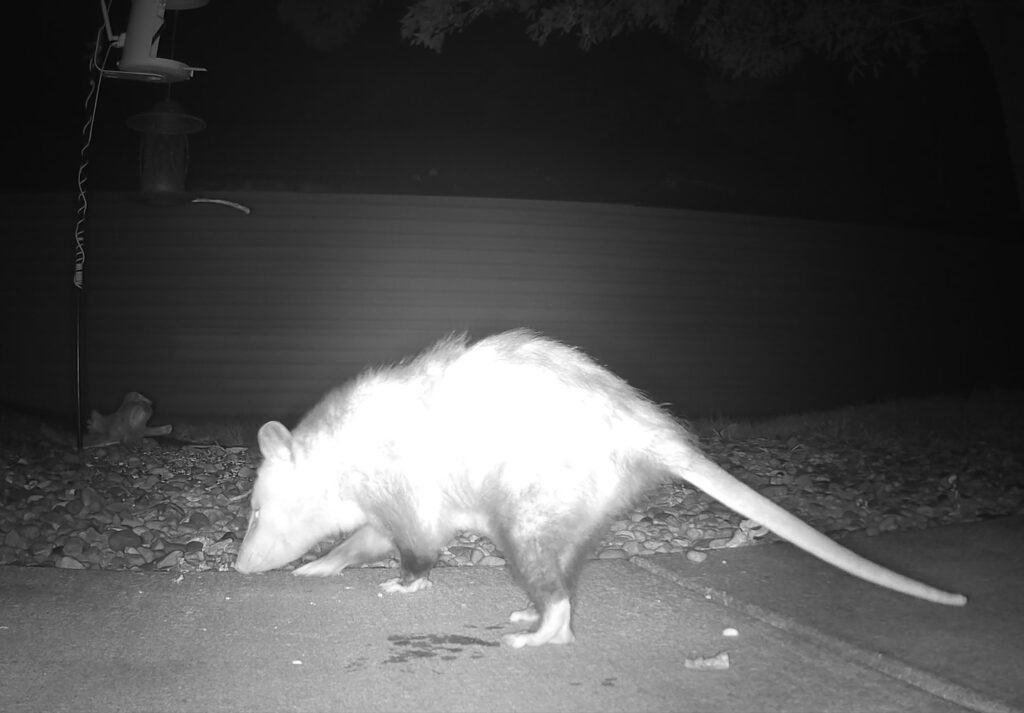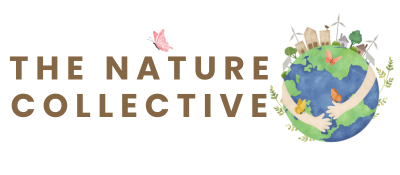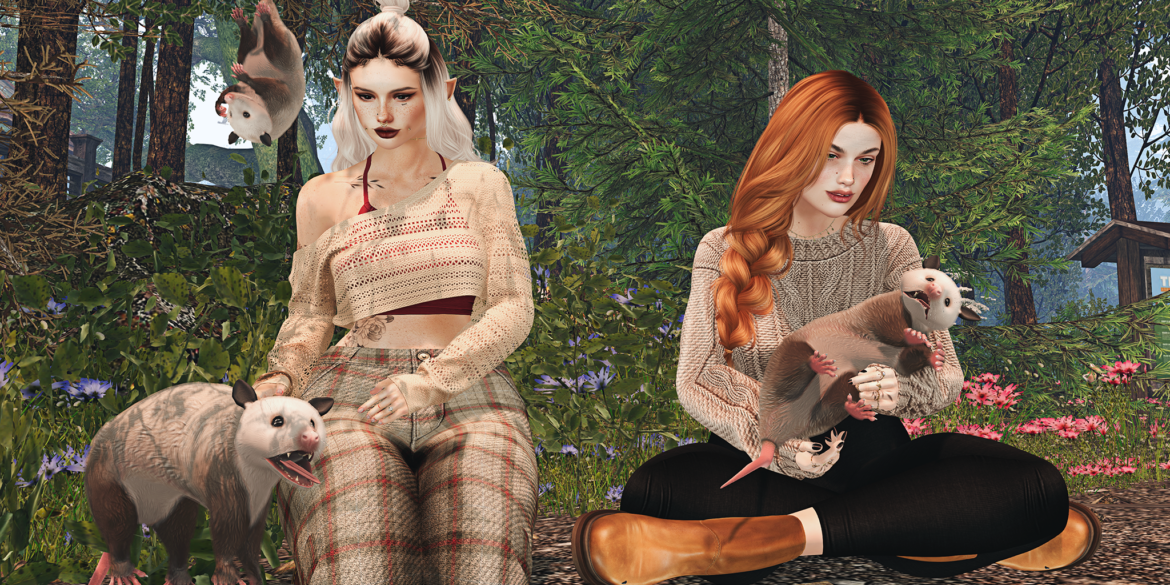(Photo taken at The Nature Collective’s Little Bear Park, in Second Life)
When I think about the most misunderstood creatures in the natural world, my nightly visitor instantly comes to mind—the opossum. This little marsupial has become a regular on my patio, quietly padding through the shadows in search of food and water. Watching videos of Moira (I tend to name all of my regular wildlife visitors), on my trail cam has sparked a deep appreciation for their unique appearance, quirky behavior, and the vital role they play in the ecosystem. So, let’s take a closer look at these incredible animals, their history, and why they deserve a little love and understanding.
Opossums: Misunderstood Marvels
Opossums, often unfairly labeled as “dirty” or “scary,” are actually fascinating, gentle creatures. They are North America’s only marsupials, meaning they carry and nurse their young in a pouch, much like kangaroos or koalas. With their grayish fur, prehensile tails, and charmingly snaggle-toothed grins, opossums are uniquely adapted to life in a variety of environments, from forests to urban backyards like mine.
Despite their reputation, opossums are clean animals that groom themselves meticulously, much like cats. They’re also incredibly shy and non-aggressive. When threatened, their famous “playing dead” act (called thanatosis) is a survival mechanism—not a choice, but an involuntary response.
A Little Opossum History
The Virginia opossum (Didelphis virginiana) is a living relic, dating back to the time of the dinosaurs. Fossil records show that their ancient relatives existed over 70 million years ago, making them one of the oldest surviving mammals in North America. They have remained relatively unchanged over the millennia, proving that they are expert survivors.
Indigenous peoples of North America recognized the value of opossums long before European settlers arrived. Many Native American tribes included opossums in their folklore, often portraying them as clever and resourceful animals. The word “opossum” itself comes from the Powhatan language, derived from “aposoum”, meaning “white dog” or “white beast.”
Early European settlers, however, misunderstood and feared opossums, leading to the myths that persist today. Despite this, they have thrived in human-altered landscapes, adapting to suburban and urban environments with impressive resilience.
Natural Pest Control Experts
One of the coolest things about opossums is their superpower: pest control. They are omnivores with a diet that includes insects, snails, slugs, rodents, and even ticks. In fact, a single opossum can consume thousands of ticks in a season, significantly reducing the spread of Lyme disease. They also help keep gardens healthy by feasting on overripe fruits and unwanted pests.
Beyond their appetite for pests, opossums are nature’s cleanup crew. They scavenge for carrion, helping to recycle nutrients and keep ecosystems clean.
Myths vs. Reality
One of the most damaging myths about opossums is that they are rabies carriers. In truth, their low body temperature (usually around 94-97°F) makes it nearly impossible for the rabies virus to survive in their system. Opossums are far more likely to hiss and scurry away than bite, making them one of the safest wild animals to encounter.
Another myth is that they are aggressive or dangerous. In reality, opossums are non-confrontational animals. Their main defense is bluffing—hissing, showing their 50 tiny teeth (the most of any North American land mammal), and, if all else fails, collapsing into a catatonic state as a last resort (a trait that I myself also exhibit from time to time).
Helping Our Wild Neighbors
If you’re lucky enough to have opossums visit your yard, there are simple ways to support them, especially during the cold winter months:
- Provide food and water: Place a small dish of fresh water and healthy snacks like fruit or cat kibble in a safe, quiet spot.
- Create shelter: Opossums will appreciate a cozy hideaway, like a brush pile or a small pet shelter filled with straw.
- Avoid poisons: Rodenticides and pesticides can harm opossums and other wildlife. Opt for humane pest control alternatives.
- Be mindful of pets: Keep dogs and outdoor cats supervised or indoors at night to avoid stress for wildlife.

Why Opossums Deserve Our Respect
Opossums remind us that every creature plays a role in the natural world, even the ones we might overlook or misunderstand. By offering them kindness and safe spaces, we’re not just helping one animal—we’re supporting an entire ecosystem.
So the next time you see an opossum waddling through your yard or spot one on a trail cam, take a moment to marvel at this misunderstood marsupial. They’re doing their best to keep our world cleaner, safer, and more balanced—one tick and slug at a time.
“Nerdy for Nature” is a blog segment by Emm Evergarden, founder of The Nature Collective SL, which highlights various nature topics and nature in the news. She hopes you enjoy all of her nerdy musings and carry the info that you might learn, within your day-to-day lives – doing your part to be a steward and caretaker of the Earth and all its inhabitants.

